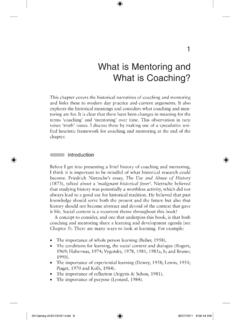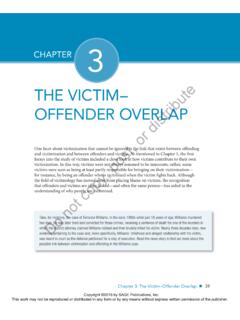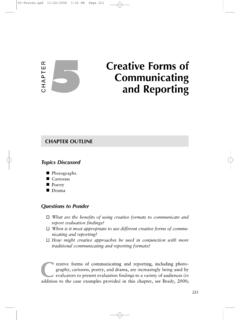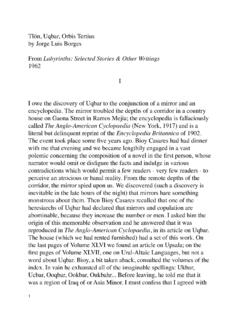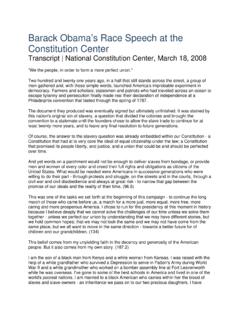Transcription of Overview - SAGE Publications Inc
1 1 Overview _____History of Trauma Theory The relationship between trauma and mental illness was first investigated by the neurologist Jean Martin Charcot, a French physician who was working with traumatized women in the Salpetriere hospital. During the late 19th century, a major focus of Charcot's study was hysteria, a disorder commonly diagnosed in women. Hysterical symptoms were characterized by sudden paralysis, amnesia, sensory loss, and convulsions. Women comprised the vast majority of patients with hysteria, and at the time, such symptoms were thought to originate in the uterus. Until Charcot, the common treatment for hysteria was hysterectomy.
2 Charcot was the first to understand that the origin of hysterical symptoms was not physiological but rather psychological in nature, although he was not interested in the inner lives of his female patients. He noted that traumatic events could induce a hypnotic state in his patients and was the first to describe both the problems of suggestibility in these patients, and the fact that hysterical attacks are dissociative problems . the results of having endured unbearable experiences (van der Kolk, Weisaeth, & van der Hart, 1996, p. 50). In Salpetriere, young women who suffered violence, rape, and sexual abuse found safety and shelter, and Charcot presented his theory to large audiences through live demonstrations in which patients were hypnotized and then helped to remember their trauma, a process that culminated in the abrogation of their symptoms (Herman, 1992).
3 Pierre Janet, a student of Charcot, continued to study dissociative phe- nomena and traumatic memories. Janet investigated the influence of patients'. traumatic experiences on personality development and behavior. He recog- nized that patients' intense affects were reactive to their perceptions of the traumatic events that happened to them, and he found that through hypnosis and abreaction, or reexposure to the traumatic memories, patients' symptoms could be alleviated (van der Kolk, Weisaeth, et al., 1996). In his early studies of hysteria (1893 1895), Freud, too, was initially influenced by Charcot and 1. 2 TRAUMA: CONTEMPORARY DIRECTIONS IN THEORY, PRACTICE, AND RESEARCH.
4 Adopted some of his ideas. In Studies on Hysteria (1893), coauthored with Josef Breuer, Freud suggested that we must point out that we consider it essential for the explanation of hysterical phenomena to assume the presence of a dissociation, a split- ting of the content of consciousness. [T]he regular and essential con- tent of a hysterical attack is the recurrence of a physical state which the patient has experience earlier. (cited in van der Kolk, Weisaeth, et al., 1996, p. 30). Freud and Breuer termed traumatic dissociation hypnoid hysteria and highlighted its relationship to a traumatic antecedent. In 1896, Freud sug- gested that a precocious experience of sexual relations.
5 Resulting from sexual abuse committed by another person .. is the specific cause [italics added] of hysteria .. not merely an agent provocateur (1896/1962, p. 195, cited in van der Kolk, Weisaeth, et al., 1996, p. 54). In the 1880s, Freud and Breuer as well as Janet independently concluded that hysteria was caused by psychological trauma. They agreed that unbearable reactions to traumatic experiences produced an altered state of consciousness that Janet called dissociation. According to Janet, dissociation manifested in hys- terical symptoms (Herman, 1992). Putting the emotions into words and reconstructing the past helped alleviate the patients' symptoms.
6 However, Freud eventually moved from what has been termed seduction theory to conflict theory (see Chapter 3 for a more detailed discussion of this development), suggesting that it was not memories of external trauma that caused hysterical symptoms but rather the unacceptable nature of sexual and aggressive wishes. What his followers neglected to notice, however, was that whereas Freud privileged intrapsychic theory and fantasy over external trauma, he did suggest that it was possible for external trauma to influence the patient's state of mind (Diamond, 2004). Ferenczi (1933/1955) was the only one among Freud's followers who regarded his patients' stories of child- hood sexual abuse as veridical recollections, but he remained somewhat of an outsider in the psychoanalytic movement during his lifetime, his theories gaining favor only in the decades following his untimely death in 1933.
7 Crisis intervention methods to address traumatic events developed gradu- ally, with the establishment of the first suicide hotline in 1902 in San Francisco. Psychological first aid was then further developed in the context of military combat. During World War I, psychiatrists observed that soldiers returned with shell shock syndrome. Psychological first aid was first developed to help World War I soldiers overcome their symptoms of uncontrollable weep- ing and screaming, memory loss, physical paralysis, and lack of responsiveness (Herman, 1992). The goal of psychological first aid was to provide a short intervention that would help the soldiers recover and return to the front as soon as possible.
8 It was observed that by providing intervention close to the front and soon after deployment, traumatized soldiers were able to overcome Chapter 1 Overview 3. their shell shock symptoms and return to active combat duty. In 1923, follow- ing World War I, Abram Kardiner started to treat traumatized war veterans (Kardiner, 1941). Like Janet and Freud, he observed the nature of reenactment, a central construct in modern trauma theory, and noted that the subject acts as if the original traumatic situation were still in existence and engages in protective devices which failed on the original occasion (p. 82;. also cited in van der Kolk, Weisaeth, et al.)
9 , 1996, p. 58). Kardiner also fore- saw an important controversy that continues to haunt trauma therapists, that is, whether to bring the traumatic memories into the patient's consciousness or to focus on stabilization (van der Kolk, van der Hart, & Marmar, 1996). Although earlier trauma theorists blamed the soldiers' symptoms on their poor moral character, Kardiner understood that any man could be affected by the atrocities of war and that the traumatic symptoms were a normal response to an unbearable situation. Kardiner and his colleague Herbert Spiegel argued that the most powerful intervention against overwhelming terror was the degree of relatedness between the soldier, his immediate fighting unit, and their leader (Herman, 1992, p.
10 25). Consequently, treatment for traumatized soldiers during the Second World War focused on minimizing separation between these soldiers and their comrades and providing brief intervention methods such as hypno- sis. Kardiner and Spiegel warned, however, that cathartic experiences and hypnosis by themselves, without consistent follow-up, were not sufficiently helpful and that unless the traumatic memories were integrated in conscious- ness the improvement would not last (Kardiner & Spiegel, 1947, cited in Herman, 1992). During World War II, psychiatrists reintroduced hypnosis as a treatment for trauma, and the Army instituted the use of group stress debriefing (Shalev & Ursano, 1990, cited in van der Kolk, Weisaeth, et al.
